What is Intermediate Switch (3-Way in IEC) A.K.A 4-Way Switch in NEC?
4-Way Switch or Intermediate Switch (3-Way) – its Construction, Operation & Applications
What is an Intermediate Switch?
4-Way switch in NEC (also known as 3-way or intermediate switch in IEC following countries) is a very useful switch with four terminals (and optional ground in the US as 4-Way) and commonly used when we need to control a light point (or any other electrical appliances like fan, alarm, in the middle of stair etc.) from three different places. It is used with a combination of two-ways switches to control an appliance from more than two places. In addition, an electric circuit can be controlled from any number of location using intermediate switches (which is known as 3-Way in the UK and 4-Way in the US).
Good to know: Intermediate Switch (3-Way) – IEC is also known as 4-way switch or crossover switch in the US – NEC. The next section will differentiate both of them.
Related Wiring Diagrams:
- How to Wire 4-Way Switch (NEC) & Intermediate Switch as 3-Way (IEC)?
- How to Wire Single Pole, Single Throw (SPST) as 2-Way & 1-Way Switch? IEC & NEC
- How to Wire Single Pole, Double Throw (SPDT) as 3-Way & 2-Way Switch? IEC & NEC
Construction & Working of Intermediate Switch
In an intermediate switch, there are four terminals by which it changes the flowing of electric current from one circuit to another (see fig 1 & 2) and is also known as Four-Way Switch (Three Way Switch in the UK & EU). It has the ability to ON and OFF the electric supply by two ways or control the single circuit from more than two places.
The four terminals of intermediate switch construction and its operation are shown in fig below where the 4 contact points may be known as A, B, C & D. When the switch knob is up, the terminal contacts of the intermediate switch connect terminal A with terminal C and terminal B with terminal D as shown in fig 1a. On the other hand when knob is down, terminal A is connected to terminal B and C to D then.
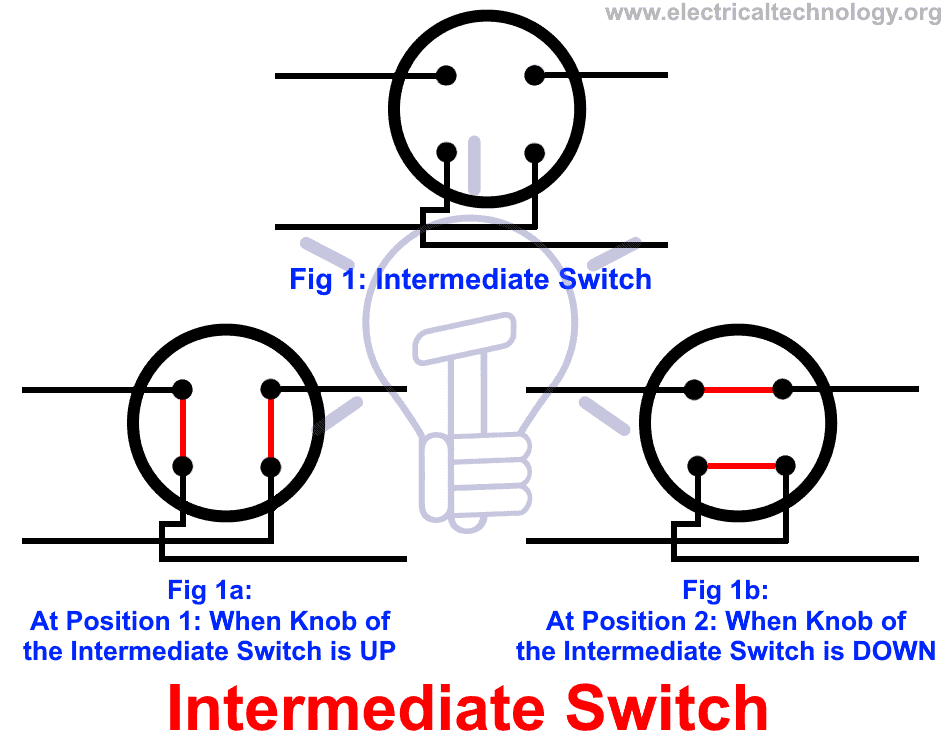
In other words, When the knob of the switch is UP, then the vertical contacts are connected in such a way like AC and BD as shown in fig 1a). And when the knob is DOWN, then the Horizontal contacts are connected (i.e. AB and CD as shown in fig 1b).
Fig 2 shows the basic construction and working of Intermediate switch.
Click image to enlarge
There is a little bit confusion about this switch due to regional codes i.e. the same DPDT (double pole, double throw) switch is labeled using different names e.g.
- UK & EU – IEC = It has 4 terminals for strappers wires to connect to the 2-way switches and known as Intermediate switch & 3-Way switch.
- US – NEC = It has 4 terminals for travelers wires to connect to the 3-way switches and additional ground terminal and known as 4-Way switch & Crossover switch.
The following figures illustrate the difference (which is not at all) between 3-Way and 4-Way switch.
The following fig and gif shows how is a 3-way switch or intermediate switch wired with 2-way switches (according to IEC) to control a lamp from 3 places. (Alternatively, a 4-way switch working with 3-way switches to control an LED lamp from three different locations according to NEC)
Click image to enlarge
Click image to enlarge
Here is the short video which shows the working of intermediate (4-Way) switch with 3-Way Switches.
Related Posts:
Application of Intermediate Switch
Intermediate switch is mostly used in large premises & big rooms such as hallway wiring, Hostel wiring, hospital wiring, tunnel wiring, godown wiring & staircase wiring where different lamps are needed to ON/OFF from different places. Moreover, in a multistory building, the lamp at ground floor or in car parking shades can be controlled or ON / OFF from any floor by using an intermediate switch circuit.
How to Control Light Point from Three Places using Intermediate Switch
In Fig 3, a lamp is controlled from three different places by using two, 2-way switches and one intermediate switch.
Below is the same diagram (Fig 4) to control a light point (lamp) from three different places by using two, two-way switches and one intermediate switch with different symbols.
The following wiring diagrams show the installation of intermediate switches according to NEC and IEC where a light bulb is controlled from three different locations.
Click image to enlarge
Related Posts:
Staircase Wiring using Intermediate Switch
Below is a given schematic circuit to control a light point from three different places by using two 2-way switches and an intermediate switch (or two 3-way and one of 4-way switch – US) in the middle of stairs.
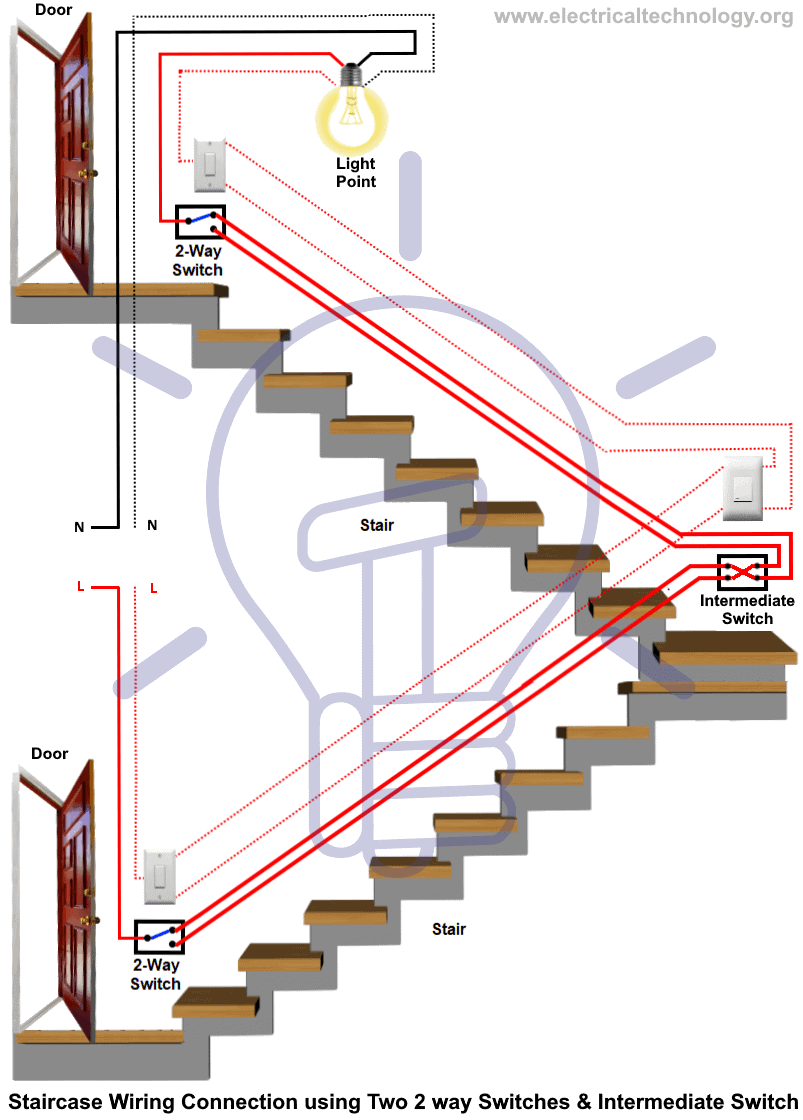
The following wiring diagrams show the same configurations for both IEC and NEC codes.
Related Posts:
- How to Control a Lamp by a Single Way or One-Way Switch?
- How to control each lamp by separately switch in parallel lighting circuit?
Controlling of Lamp from Five or Six Places using Intermediate Switch
In fig 5, a lamp is controlled from six different places by using two, 2-way switches and four intermediate switches.
Key Point: You may control a lamp from many different places by adding more intermediate switches such as in the middle of stair or in shared flats (when needed). Also, many other electrical appliances like fans, alarms, machines etc. can be controlled from different places by using an intermediate switch.
Click image to enlarge
Related Posts:
- How to Wire an Outlet Receptacle? Socket Outlet Wiring Diagrams
- How to Find the Number of Outlets on a Single Circuit Breaker?
- How to Find Voltage & Ampere Rating of Switch, Plug, Outlet & Receptacle
- How to Wire a Pilot Light Switch? Wiring of 2 & 3 Way Neon Light Switches
- How to Wire Combo Switch and Outlet? – Switch/Outlet Combo Wiring Diagrams
- How to Wire an AFCI Combo Switch – AFCI Switch Wiring Diagrams
- How to Wire GFCI Combo Switch and Outlet – GFCI Switch/Outlet Wiring Diagrams
- How to Control Water Heater using Switches?
- How to Wire a Ceiling Fan? Dimmer Switch and Remote Control Wiring
- How to Wire Auto & Manual Changeover & Transfer Switch – (1 & 3 Phase)
- Automatic Bathroom Light Switch Circuit Diagram and Operation
- Staircase Wiring Circuit Diagram – How to Control a Lamp from 2 Places by 2-Way Switches?
- 2 Way Switch – How to Control One Lamp From Two or Three Places?
- How to Control One Light Bulb from Six Different Places using 2-Way & Intermediate Switches?
- Corridor Wiring Circuit Diagram – Hallway Wiring using 2-Way Switches
- Hospital Wiring Circuit for Light Control using Switches
- Tunnel Wiring Circuit Diagram for Light Control using Switches
- Godown Wiring Diagram -Tunnel Wiring Circuit and Working
- Hostel Wiring Circuit Diagram and Working
- How to Wire a UK 3-Pin Plug? Wiring a BS1363 Plug
- How to Wire a UK 3-Pin Socket Outlet? Wiring a BS1363 Socket
- How to Wire a Twin 3-Pin Socket Outlet? Wiring 2-Gang Socket
- How to Wire Combo Switch and Outlet? – Switch/Outlet Combo Wiring Diagrams
- Switch and Push Button Symbols
- Basic Electrical Wiring Diagrams
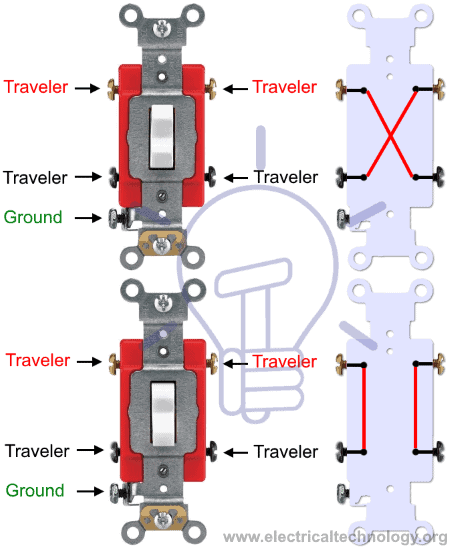

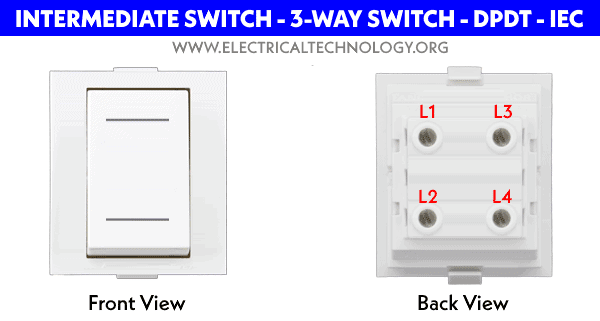
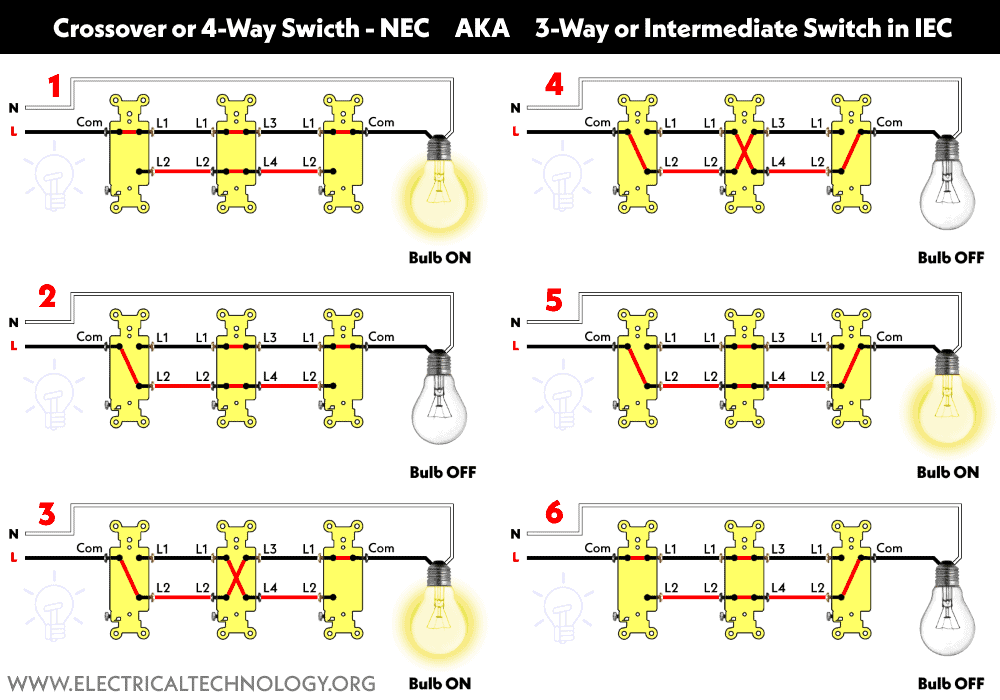
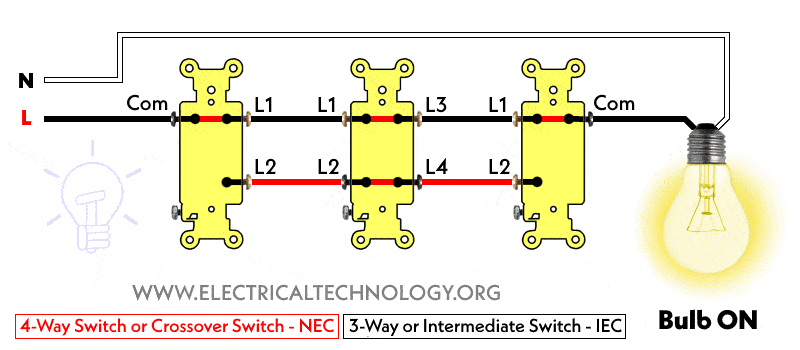


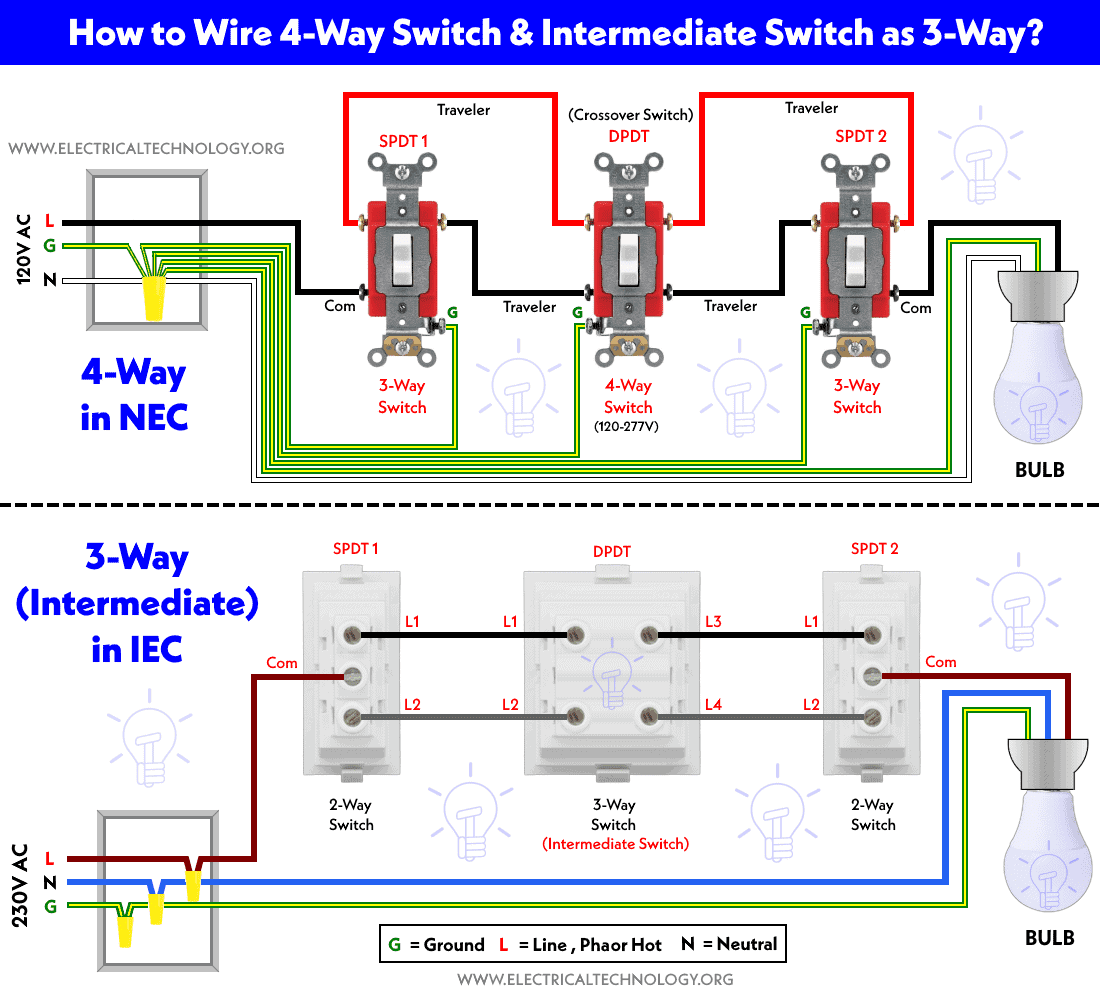
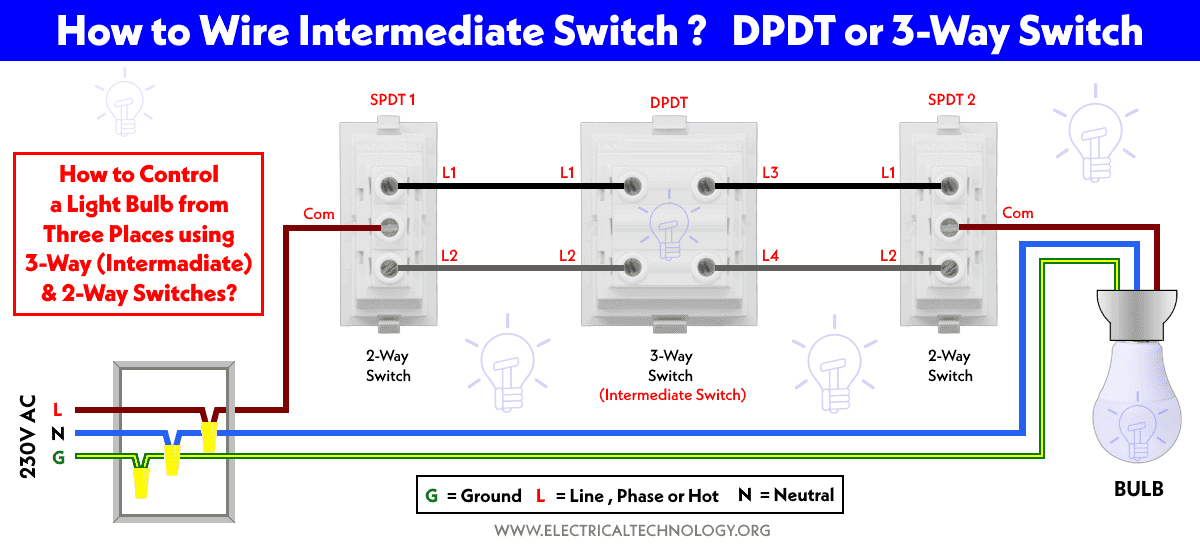
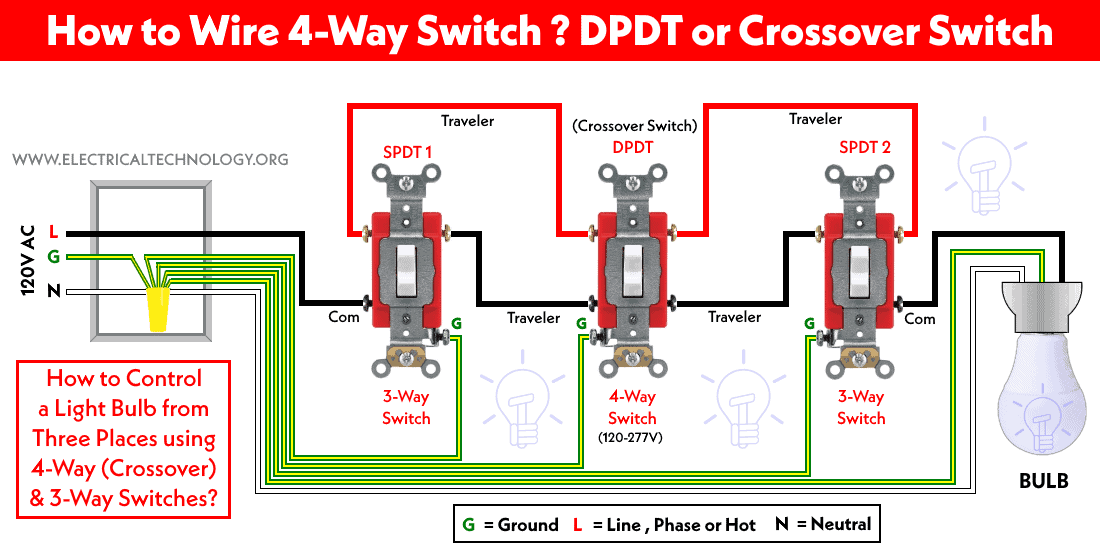
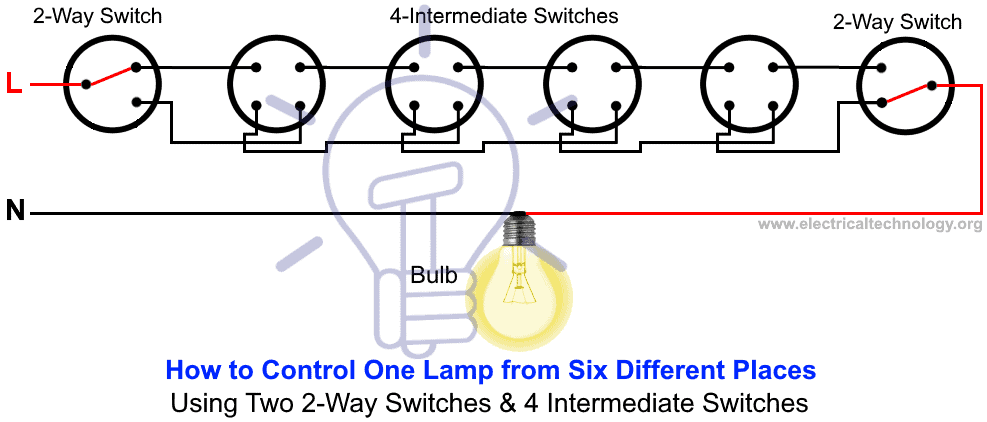
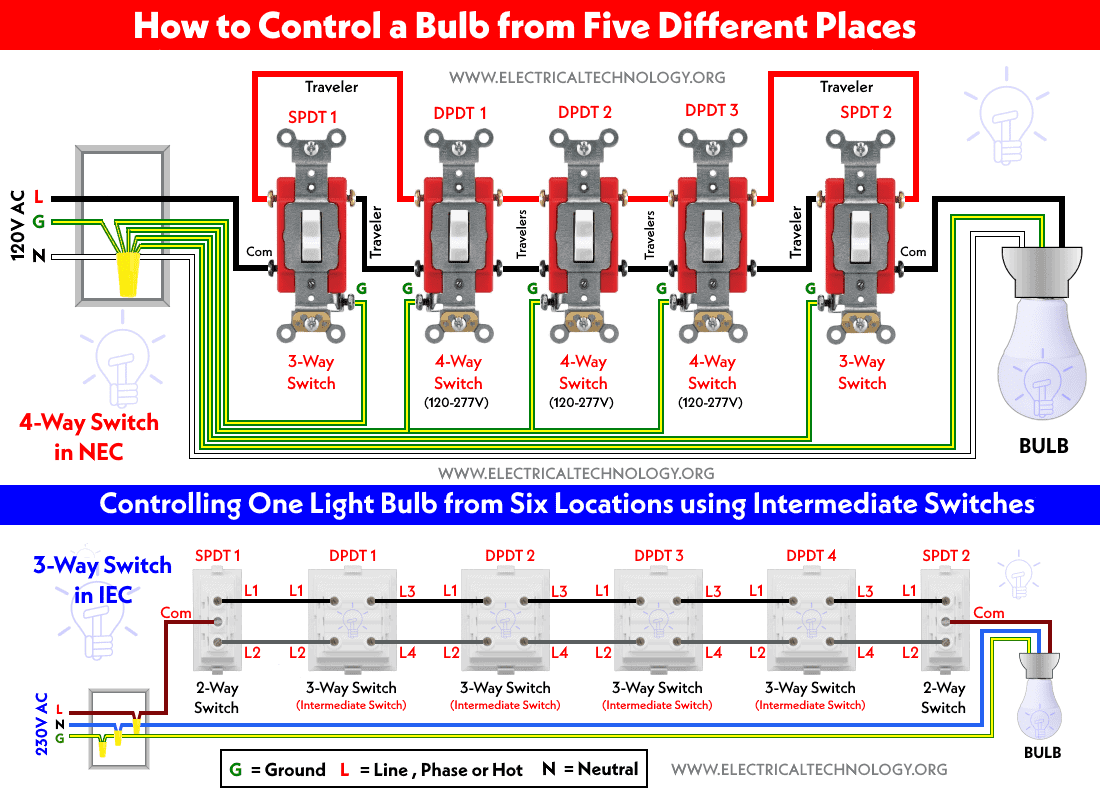







Almost every area of society from homes to businesses has become saturated with electrical technology like computers and electrical circuits. The need for constant technological updates and maintenance provides students with numerous career and educational opportunities. Career training in electrical engineering is available for students that want to contribute to the industry.
There are many factors that can disturb your safety while working with electrical equipment and electrical installations. As electrical construction of Brisbane is popular, so is the safety of electrical construction.
Really I appreciate the effort you made to share the knowledge about Electrical. We are a Commercial Electrical Contractor
This is what we Yanks call a “four-way” switch.
thank a lot this blog
This web is very useful to us
I wants intermediate switch plz give me ratet
Your giagram misspells intermediate in two places and leaves out the ‘i’ in ‘posItion.
You diagram uses two different misspellings of intermediate just as my first email misspelled diagram. Position is missing the ‘i’.
Basic stuff not worth pulishing
You should find a different web site.
There are a LOT of folks who appreciate this information.
Remember, not everyone is an Electrical Genius like you.